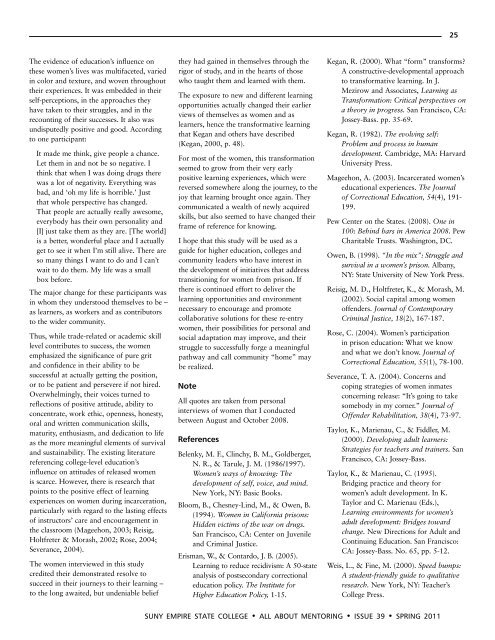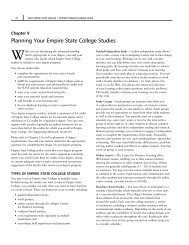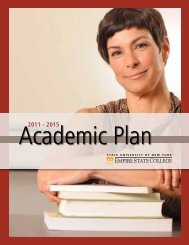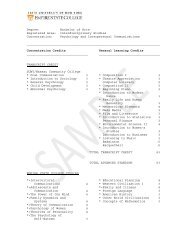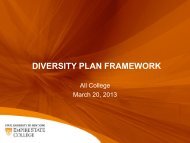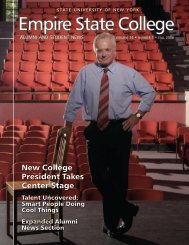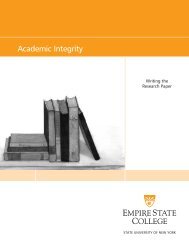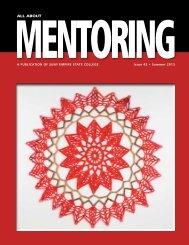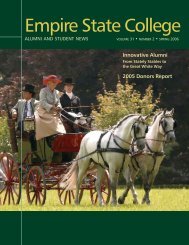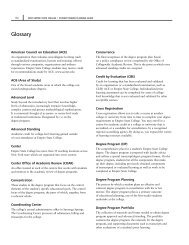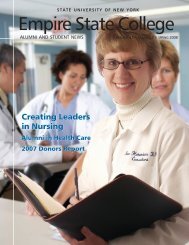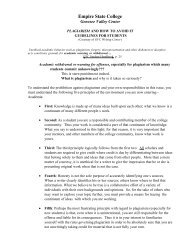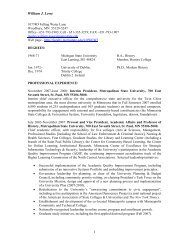All About Mentoring Spring 2011 - SUNY Empire State College
All About Mentoring Spring 2011 - SUNY Empire State College
All About Mentoring Spring 2011 - SUNY Empire State College
Create successful ePaper yourself
Turn your PDF publications into a flip-book with our unique Google optimized e-Paper software.
25<br />
The evidence of education’s influence on<br />
these women’s lives was multifaceted, varied<br />
in color and texture, and woven throughout<br />
their experiences. It was embedded in their<br />
self-perceptions, in the approaches they<br />
have taken to their struggles, and in the<br />
recounting of their successes. It also was<br />
undisputedly positive and good. According<br />
to one participant:<br />
It made me think, give people a chance.<br />
Let them in and not be so negative. I<br />
think that when I was doing drugs there<br />
was a lot of negativity. Everything was<br />
bad, and ‘oh my life is horrible.’ Just<br />
that whole perspective has changed.<br />
That people are actually really awesome,<br />
everybody has their own personality and<br />
[I] just take them as they are. [The world]<br />
is a better, wonderful place and I actually<br />
get to see it when I’m still alive. There are<br />
so many things I want to do and I can’t<br />
wait to do them. My life was a small<br />
box before.<br />
The major change for these participants was<br />
in whom they understood themselves to be –<br />
as learners, as workers and as contributors<br />
to the wider community.<br />
Thus, while trade-related or academic skill<br />
level contributes to success, the women<br />
emphasized the significance of pure grit<br />
and confidence in their ability to be<br />
successful at actually getting the position,<br />
or to be patient and persevere if not hired.<br />
Overwhelmingly, their voices turned to<br />
reflections of positive attitude, ability to<br />
concentrate, work ethic, openness, honesty,<br />
oral and written communication skills,<br />
maturity, enthusiasm, and dedication to life<br />
as the more meaningful elements of survival<br />
and sustainability. The existing literature<br />
referencing college-level education’s<br />
influence on attitudes of released women<br />
is scarce. However, there is research that<br />
points to the positive effect of learning<br />
experiences on women during incarceration,<br />
particularly with regard to the lasting effects<br />
of instructors’ care and encouragement in<br />
the classroom (Mageehon, 2003; Reisig,<br />
Holtfreter & Morash, 2002; Rose, 2004;<br />
Severance, 2004).<br />
The women interviewed in this study<br />
credited their demonstrated resolve to<br />
succeed in their journeys to their learning –<br />
to the long awaited, but undeniable belief<br />
they had gained in themselves through the<br />
rigor of study, and in the hearts of those<br />
who taught them and learned with them.<br />
The exposure to new and different learning<br />
opportunities actually changed their earlier<br />
views of themselves as women and as<br />
learners, hence the transformative learning<br />
that Kegan and others have described<br />
(Kegan, 2000, p. 48).<br />
For most of the women, this transformation<br />
seemed to grow from their very early<br />
positive learning experiences, which were<br />
reversed somewhere along the journey, to the<br />
joy that learning brought once again. They<br />
communicated a wealth of newly acquired<br />
skills, but also seemed to have changed their<br />
frame of reference for knowing.<br />
I hope that this study will be used as a<br />
guide for higher education, colleges and<br />
community leaders who have interest in<br />
the development of initiatives that address<br />
transitioning for women from prison. If<br />
there is continued effort to deliver the<br />
learning opportunities and environment<br />
necessary to encourage and promote<br />
collaborative solutions for these re-entry<br />
women, their possibilities for personal and<br />
social adaptation may improve, and their<br />
struggle to successfully forge a meaningful<br />
pathway and call community “home” may<br />
be realized.<br />
Note<br />
<strong>All</strong> quotes are taken from personal<br />
interviews of women that I conducted<br />
between August and October 2008.<br />
References<br />
Belenky, M. F., Clinchy, B. M., Goldberger,<br />
N. R., & Tarule, J. M. (1986/1997).<br />
Women’s ways of knowing: The<br />
development of self, voice, and mind.<br />
New York, NY: Basic Books.<br />
Bloom, B., Chesney-Lind, M., & Owen, B.<br />
(1994). Women in California prisons:<br />
Hidden victims of the war on drugs.<br />
San Francisco, CA: Center on Juvenile<br />
and Criminal Justice.<br />
Erisman, W., & Contardo, J. B. (2005).<br />
Learning to reduce recidivism: A 50-state<br />
analysis of postsecondary correctional<br />
education policy. The Institute for<br />
Higher Education Policy, 1-15.<br />
Kegan, R. (2000). What “form” transforms<br />
A constructive-developmental approach<br />
to transformative learning. In J.<br />
Mezirow and Associates, Learning as<br />
Transformation: Critical perspectives on<br />
a theory in progress. San Francisco, CA:<br />
Jossey-Bass. pp. 35-69.<br />
Kegan, R. (1982). The evolving self:<br />
Problem and process in human<br />
development. Cambridge, MA: Harvard<br />
University Press.<br />
Mageehon, A. (2003). Incarcerated women’s<br />
educational experiences. The Journal<br />
of Correctional Education, 54(4), 191-<br />
199.<br />
Pew Center on the <strong>State</strong>s. (2008). One in<br />
100: Behind bars in America 2008. Pew<br />
Charitable Trusts. Washington, DC.<br />
Owen, B. (1998). “In the mix”: Struggle and<br />
survival in a women’s prison. Albany,<br />
NY: <strong>State</strong> University of New York Press.<br />
Reisig, M. D., Holtfreter, K., & Morash, M.<br />
(2002). Social capital among women<br />
offenders. Journal of Contemporary<br />
Criminal Justice, 18(2), 167-187.<br />
Rose, C. (2004). Women’s participation<br />
in prison education: What we know<br />
and what we don’t know. Journal of<br />
Correctional Education, 55(1), 78-100.<br />
Severance, T. A. (2004). Concerns and<br />
coping strategies of women inmates<br />
concerning release: “It’s going to take<br />
somebody in my corner.” Journal of<br />
Offender Rehabilitation, 38(4), 73-97.<br />
Taylor, K., Marienau, C., & Fiddler, M.<br />
(2000). Developing adult learners:<br />
Strategies for teachers and trainers. San<br />
Francisco, CA: Jossey-Bass.<br />
Taylor, K., & Marienau, C. (1995).<br />
Bridging practice and theory for<br />
women’s adult development. In K.<br />
Taylor and C. Marienau (Eds.),<br />
Learning environments for women’s<br />
adult development: Bridges toward<br />
change. New Directions for Adult and<br />
Continuing Education. San Francisco:<br />
CA: Jossey-Bass. No. 65, pp. 5-12.<br />
Weis, L., & Fine, M. (2000). Speed bumps:<br />
A student-friendly guide to qualitative<br />
research. New York, NY: Teacher’s<br />
<strong>College</strong> Press.<br />
suny empire state college • all about mentoring • issue 39 • spring <strong>2011</strong>


